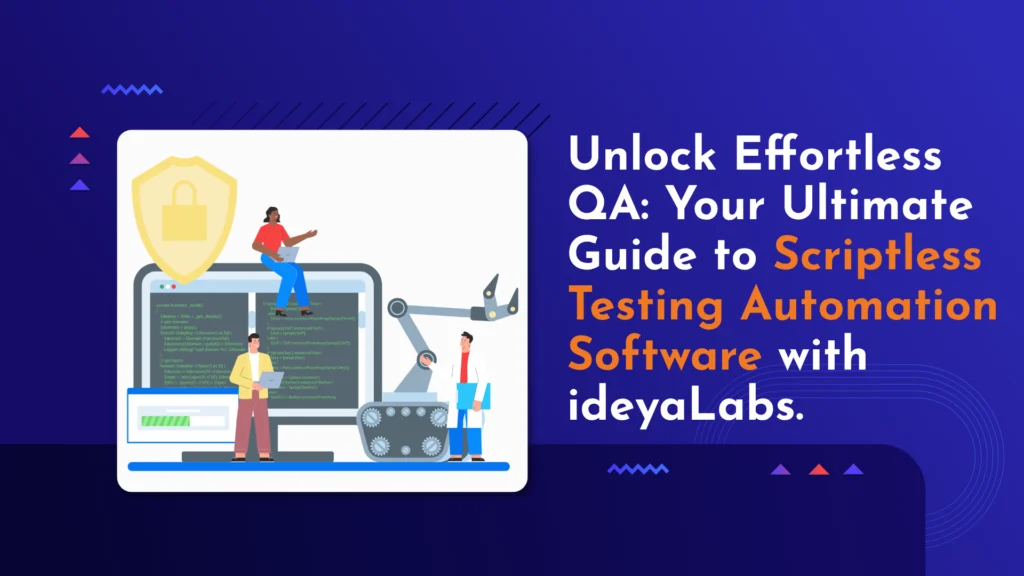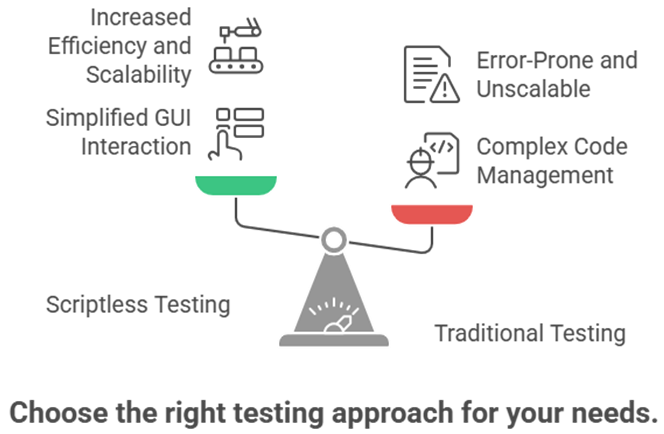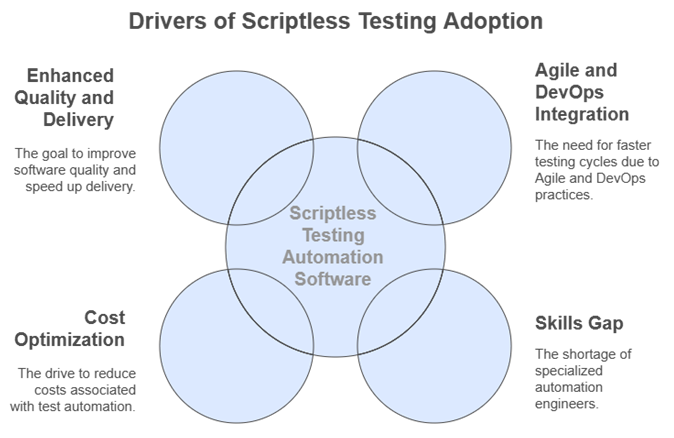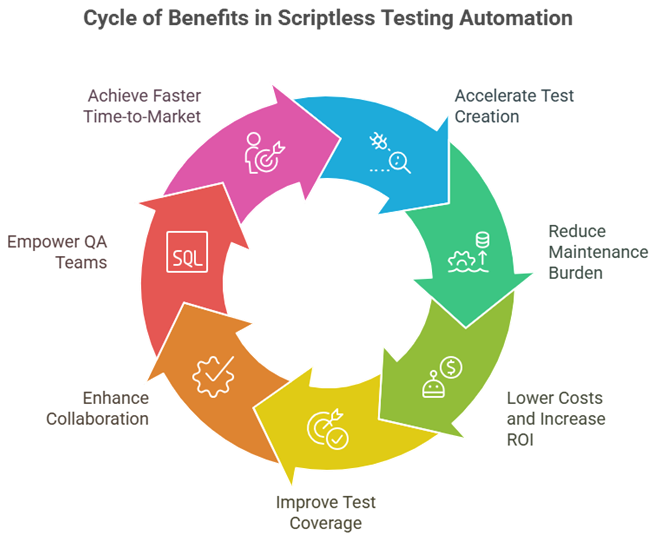
I. Introduction: The Shift Towards Smarter Testing
The digital landscape is evolving at an unprecedented pace, compelling businesses to accelerate their software development lifecycles without compromising on quality. Applications are becoming increasingly complex, feature-rich, and are expected to perform flawlessly across a multitude of devices and platforms. In this high-stakes environment, traditional testing methodologies, particularly script-based automation, often struggle to keep up. They can be slow to implement, demand specialized coding expertise, prove costly to maintain, and ultimately create significant bottlenecks that hinder agility. The pressure to deliver faster, more reliable software is immense, and outdated testing approaches are no longer sustainable. This is where a transformative paradigm shift is occurring, steering the industry towards more intelligent, efficient, and accessible solutions. Scriptless Testing Automation Software is emerging as a powerful catalyst in this evolution, promising to redefine how organizations approach quality assurance and achieve superior outcomes. This comprehensive guide will delve into the intricacies of Scriptless Testing Automation Software, exploring its benefits, functionalities, and why it’s rapidly becoming an indispensable asset for forward-thinking businesses. We will also explore how ideyaLabs is pioneering this space, empowering organizations to embrace the future of testing with confidence and ease, a topic we will revisit with more specific insights into our unique offerings later in this discussion.
II. What Exactly is Scriptless Testing Automation Software? Demystifying the Innovation

At its core, Scriptless Testing Automation Software represents a revolutionary approach to automating software tests without the need for testers to write traditional, complex code. Instead of lines of Java, Python, or C#, testers interact with intuitive graphical user interfaces (GUIs), leveraging features like drag-and-drop functionality, visual workflow modeling, record-and-playback capabilities, and sometimes even natural language processing (NLP) or model-based testing techniques to construct and execute automated test cases. The fundamental principle behind this innovation is the abstraction of underlying coding complexities. This allows testing teams, including those with limited or no programming background, to focus their efforts on defining robust test logic, validating business requirements, and ensuring comprehensive test coverage, rather than getting bogged down in the intricacies of script development and maintenance. It’s crucial to understand that “scriptless” doesn’t necessarily mean an absolute absence of scripts; rather, the scripts are generated and managed by the tool itself, hidden from the user unless deeper customization is optionally sought. This approach is a significant leap from purely manual testing, which is error-prone and unscalable for modern development speeds, and it offers a more accessible and efficient alternative to traditional, code-heavy automation frameworks. Terms like “no-code test automation” and “codeless testing” are often used interchangeably with Scriptless Testing Automation Software, all pointing towards this user-centric, efficiency-driven methodology.
III. Why is the Industry Embracing Scriptless Testing Automation Software? Key Drivers and Imperatives

The rapid adoption of Scriptless Testing Automation Software across the software development industry is not a fleeting trend but a response to several compelling drivers and urgent imperatives. Firstly, the pervasive adoption of Agile methodologies, DevOps practices, and Continuous Integration/Continuous Delivery (CI/CD) pipelines has created an insatiable demand for significantly faster and more frequent testing cycles. Traditional automation often cannot keep pace with these accelerated development cadences. Secondly, a persistent and widely acknowledged skills gap exists in the availability of specialized automation engineers who possess deep coding expertise. Scriptless solutions democratize test automation, empowering a broader pool of talent, including manual testers, business analysts, and subject matter experts, to actively participate in and contribute to automation efforts. This not only alleviates the bottleneck created by the scarcity of coding specialists but also leverages the invaluable domain knowledge these individuals possess. Furthermore, organizations are under constant pressure to optimize costs. The development, and more significantly, the long-term maintenance of complex, code-based test suites can be prohibitively expensive. Scriptless tools promise a lower total cost of ownership by reducing the initial setup time, minimizing the need for specialized (and often more expensive) resources, and simplifying the ongoing maintenance of test assets. The overarching goal is to enhance software quality and accelerate software delivery, and Scriptless Testing Automation Software provides a pragmatic and powerful pathway to achieving these critical business objectives.
IV. Unpacking the Powerful Benefits of Scriptless Testing Automation Software

The adoption of Scriptless Testing Automation Software is not merely about keeping up with trends; it’s about unlocking a cascade of tangible benefits that directly impact an organization’s efficiency, quality, and bottom line. These advantages are compelling and address many of the long-standing pain points associated with traditional, code-heavy automation. One of the most immediate and significant benefits is Accelerated Test Creation and Execution. By eliminating the need for intricate coding, testers can design and implement automated tests in a fraction of the time it would typically take. Visual interfaces and intuitive workflows mean that test cases can be assembled rapidly, leading to quicker feedback loops and faster overall testing cycles. Closely related is the Reduced Maintenance Burden. Test scripts, especially those tightly coupled with the application’s UI, are notoriously brittle and prone to breaking with even minor application changes. Scriptless tools often build in more resilience, and some advanced platforms even offer self-healing capabilities, where the tool intelligently adapts to minor UI modifications, drastically cutting down the time and effort spent on test script maintenance. This directly translates into Lower Costs and Higher Return on Investment (ROI). The initial investment in scriptless tools can be offset by savings on specialized, highly paid automation engineers, reduced training times, and significantly lower long-term maintenance overhead. The ability to achieve automation goals faster and with fewer resources leads to a much quicker and more substantial ROI. Furthermore, Scriptless Testing Automation Software facilitates Improved Test Coverage. Because tests can be created more quickly and by a wider range of personnel, teams can afford to automate a broader spectrum of test scenarios, including end-to-end flows, regression suites, and various functional checks across different platforms and devices. This enhanced coverage leads to earlier detection of defects and ultimately higher software quality. Another crucial advantage is Enhanced Collaboration. The visual nature of scriptless tests makes them more understandable to non-technical stakeholders, such as business analysts and product owners. This transparency fosters better communication and collaboration between development, QA, and business teams, ensuring that tests are accurately aligned with business requirements. This also leads to the Empowerment of QA Teams, allowing skilled manual testers, who possess deep domain and application knowledge, to transition into automation roles without needing to become expert coders. They can leverage their existing expertise to create meaningful and effective automated tests. Ultimately, all these benefits converge towards achieving Faster Time-to-Market. By streamlining the testing process, reducing bottlenecks, and improving efficiency, Scriptless Testing Automation Software enables organizations to release high-quality software to the market more rapidly, providing a significant competitive advantage. The advantages of Scriptless Testing Automation Software are clear, making it a strategic imperative for businesses aiming for agility and excellence.
V. How Does Scriptless Testing Automation Software Work? A Look Under the Hood
Understanding how Scriptless Testing Automation Software achieves its remarkable efficiency without demanding coding expertise requires a peek into its underlying mechanisms and common operational paradigms. While specific implementations vary between tools, several core principles and technologies are prevalent. Visual Test Design is often a cornerstone, where testers utilize intuitive drag-and-drop interfaces, flowcharts, or visual models to construct test cases. Pre-defined action blocks, conditional logic elements, and verification points can be visually assembled to map out complex test scenarios. This visual representation makes the test flow easy to understand, modify, and maintain. Intelligent Record and Playback is another common feature, but it has evolved significantly from the brittle record-and-playback tools of the past. Modern scriptless platforms offer more sophisticated recording capabilities that capture user interactions with the application and translate them into editable, robust test steps. Crucially, these tools often incorporate advanced Object Recognition and Management techniques. They can identify UI elements (buttons, fields, links, etc.) using a variety of locators (ID, XPath, CSS selectors, AI-powered visual locators) and often provide mechanisms to manage these object repositories efficiently, making tests less susceptible to minor UI changes. Many scriptless tools also provide robust support for Data-Driven Testing. This allows testers to easily create a single test case that can be executed with multiple sets of input data, typically sourced from spreadsheets, databases, or internal data generators. This is essential for validating application behavior across a wide range of data scenarios without creating redundant test scripts. Increasingly, Artificial Intelligence (AI) and Machine Learning (ML) are being integrated into Scriptless Testing Automation Software. These technologies can power features like self-healing scripts (where the tool automatically adapts tests when it detects minor UI changes), intelligent test generation based on application models, anomaly detection in test results, and optimized test execution. While the user experience remains scriptless, these sophisticated technologies work behind the scenes to enhance the power, resilience, and intelligence of the automation process. The tool effectively translates these visual designs, recorded actions, and configurations into executable instructions that interact with the application under test, performing actions and verifying outcomes just as a coded script would, but without exposing the user to that level of complexity.
VI. Key Features to Look for in Leading Scriptless Testing Automation Software
When evaluating Scriptless Testing Automation Software for your organization, it’s crucial to look beyond the basic promise of “no code” and assess a range of key features that determine the tool’s true power, usability, and long-term value. A truly Intuitive User Interface (UI) and User Experience (UX) is paramount. The platform should be easy to learn and navigate, even for team members with no prior automation experience. Complex tasks should be achievable through straightforward visual means. Comprehensive Cross-Browser and Cross-Platform Support is essential in today’s diverse technological landscape. The ideal tool should allow you to create tests once and execute them seamlessly across various web browsers (Chrome, Firefox, Safari, Edge), operating systems (Windows, macOS, Linux), and device types, including mobile platforms (iOS and Android) and APIs. Robust Object Identification and Management capabilities are critical for test stability and maintainability. Look for tools that offer multiple locator strategies, intelligent object spying features, and a centralized object repository that allows for easy updates if UI elements change. The ability to create Reusable Test Components and Modularity is key to efficient test development. Good scriptless tools allow testers to create common sequences of steps or functions as reusable components that can be called across multiple test cases, reducing duplication and simplifying maintenance. As mentioned earlier, strong Data-Driven Testing Support is a must-have, enabling the execution of tests with various data inputs without script modification. Furthermore, Integration Capabilities are vital for fitting the scriptless automation tool into your existing development ecosystem. It should integrate smoothly with popular CI/CD tools (like Jenkins, GitLab CI, Azure DevOps), test management platforms (like Jira, TestRail), and bug tracking systems. This ensures that automated testing becomes an integral part of your development pipeline. Comprehensive Reporting and Analytics are necessary to gain insights into test execution results, identify failure patterns, track quality trends, and communicate progress to stakeholders. Look for customizable dashboards, detailed logs, and visual reports. The platform must also offer Scalability and Performance, capable of handling a growing number of test cases and executing them efficiently, perhaps with parallel execution capabilities, to provide quick feedback. Lastly, consider the availability of reliable Support and a strong Community. Good vendor support, comprehensive documentation, tutorials, and an active user community can be invaluable for troubleshooting issues and learning best practices. As you evaluate options, consider how ideyaLabs’ offerings align with these critical features, a point we will elaborate on when we discuss our specific solutions.
VII. Scriptless vs. Script-Based Automation: Making the Right Choice for Your Team
While Scriptless Testing Automation Software offers a compelling array of advantages, it’s also useful to understand its position relative to traditional script-based automation to make informed decisions for your team. Script-based automation, which involves writing code in languages like Java, Python, or JavaScript using frameworks like Selenium or Cypress, has long been the mainstay for many organizations. Its strength lies in its ultimate flexibility and control; complex, highly customized test scenarios can be meticulously crafted, and engineers have granular command over every aspect of test execution. However, this power comes at the cost of requiring specialized programming skills, longer development times, and often, significantly higher maintenance efforts as applications evolve.
Scriptless automation, on the other hand, shines brightly in scenarios where speed, accessibility, and ease of maintenance are paramount. It excels in enabling rapid test development for common to moderately complex applications, especially for UI and API testing. Its visual nature and abstraction of code make it ideal for teams with a mix of technical and non-technical testers, fostering broader participation in automation. For most mainstream enterprise applications and web/mobile testing needs, modern Scriptless Testing Automation Software provides more than sufficient power and flexibility, coupled with a much lower barrier to entry and a faster path to ROI. The trend is clear: while script-based approaches may still have a niche for deeply technical or uniquely complex edge cases, scriptless solutions are increasingly becoming the dominant and preferred approach for many test automation requirements, offering a more pragmatic balance of capability and efficiency.
VIII. Navigating Common Myths About Scriptless Testing Automation Software
As with any transformative technology, several misconceptions have emerged around Scriptless Testing Automation Software. It’s important to address these myths to have a clear understanding of its true capabilities and scope.
One common myth is that scriptless automation is only suitable for very simple tests. While early iterations of scriptless tools might have had limitations, modern platforms are highly sophisticated and capable of handling complex test scenarios, including intricate workflows, data-driven tests, API validations, and end-to-end business process automation. They offer features that cater to a wide range of testing needs, far beyond basic smoke tests.
Another misconception is that “scriptless” means an absolute absence of code under all circumstances. While the primary mode of operation and test creation is indeed code-free, many advanced scriptless platforms offer optional low-code capabilities. This means that for highly specific or unique requirements, users with some technical inclination can extend the tool’s functionality with small code snippets if desired. However, the core value proposition remains that most of the test automation can be achieved without any coding, making it accessible to everyone.
Finally, some believe that testers using scriptless tools don’t need any technical understanding or testing knowledge. This is far from the truth. While the tool handles coding complexity, a solid understanding of software testing principles, test design techniques, application domain knowledge, and logical thinking remain crucial for creating effective and meaningful automated tests. Scriptless tools empower testers by removing the coding barrier, allowing them to focus their expertise on what to test and how to test it from a business and user perspective, rather than struggling with programming syntax.
IX. Introducing ideyaLabs: Your Partner for Next-Generation Scriptless Test Automation
Now that we’ve explored the compelling landscape of Scriptless Testing Automation Software – its definition, drivers, benefits, working mechanisms, key features, and common myths – it’s time to consider how your organization can effectively harness this transformative power. This is where ideyaLabs step in as your trusted partner. We understand that transitioning to or scaling your test automation efforts requires not just a tool, but a comprehensive strategy and expert guidance. Our dedicated QA services, detailed at ideyaLabs iTAF, showcase our broader expertise in ensuring software quality.
At ideyaLabs, we are poised to deliver cutting-edge Scriptless Testing Automation solutions designed to meet diverse organizational needs and a wide range of user expectations from an automation platform.

Our approach is not just about providing software; it’s about partnering with you to achieve tangible results: drastically reduced testing timelines, significant cost savings, vastly improved software quality, and ultimately, a faster, more confident path to market for your critical applications. We are committed to helping you leverage Scriptless Testing Automation Software to its fullest potential.
X. Getting Started with Scriptless Testing Automation Software: A Practical Approach
Embarking on your Scriptless Testing Automation Software journey can be a smooth and rewarding process if approached strategically. The goal is to achieve quick wins, build momentum, and gradually scale your automation efforts across the organization. A practical first step is to identify suitable pilot projects. Look for applications or modules that are relatively stable, have well-defined functionalities, and where automation can deliver clear and immediate benefits, such as repetitive regression suites or critical business workflows. This allows your team to gain experience with the chosen scriptless tool and demonstrate its value early on. Concurrently, the selection of the right tool is paramount. Evaluate potential Scriptless Testing Automation Software based on the key features discussed earlier, considering your specific technical environment, team skills, application types (web, mobile, API), and integration needs. Naturally, we believe ideyaLabs presents a compelling option, designed to meet these diverse requirements effectively. Once a tool is selected, invest in training your team. While scriptless tools significantly lower the learning curve compared to traditional coding, users still need to understand the tool’s features, best practices for test design, and how to manage test assets efficiently. Most reputable vendors, including ideyaLabs, offer comprehensive training resources and support. It’s also crucial to define clear goals and metrics for success from the outset. What do you aim to achieve with scriptless automation? Faster testing cycles? Increased test coverage? Reduced manual effort? Cost savings? Establishing measurable objectives will help you track progress and demonstrate the ROI of your automation initiative. Finally, embrace an iterative approach: iterate and scale. Start with your pilot projects, learn from the experience, refine your processes, and then gradually expand your scriptless automation footprint to other applications and teams. This phased rollout ensures a manageable transition and maximizes the chances of long-term success.
XI. The Future is Scriptless: Trends Shaping Test Automation
The domain of test automation is continuously evolving, and Scriptless Testing Automation Software is at the vanguard of this transformation. Several exciting trends are shaping its future, promising even more intelligent, efficient, and integrated testing solutions. We are witnessing greater AI and Machine Learning (AI/ML) integration into these platforms. This goes beyond simple record-and-playback to encompass AI-driven test case generation, intelligent object recognition that adapts to UI changes (self-healing tests), predictive analytics to identify high-risk areas for testing, and smart test execution prioritization. The industry is also moving towards increased focus on autonomous testing, where the system can independently learn the application, generate tests, execute them, and even analyze results with minimal human intervention. This vision aims to further reduce the manual effort involved in testing the lifecycle. Another significant trend is closer and more seamless integration with the entire DevOps toolchain. Scriptless automation tools are becoming more deeply embedded within CI/CD pipelines, version control systems, and collaboration platforms, ensuring that testing is a continuous and integral part of the software development process, not an afterthought. Furthermore, the capabilities of Scriptless Testing Automation Software are expanding into new and more specialized areas of testing, such as performance testing, security testing, and accessibility testing, all within a unified, code-free or low-code environment. As these trends mature, Scriptless Testing Automation Software will become even more indispensable for organizations striving to deliver high-quality software at the speed of modern business.
XII. Conclusion: Embrace Effortless Automation and Elevate Your Quality with ideyaLabs
In the dynamic and demanding world of modern software development, the pursuit of speed, efficiency, and uncompromised quality is paramount. As we have explored throughout this guide, Scriptless Testing Automation Software has unequivocally emerged as a critical enabler for achieving these objectives. It effectively dismantles the traditional barriers of coding complexity, resource dependency, and slow testing cycles that have long plagued QA initiatives. By empowering a broader range of team members, accelerating test creation and maintenance, reducing costs, and fostering greater collaboration, scriptless automation is not just a tool, but a strategic imperative for any organization serious about digital excellence. The benefits are clear and compelling, offering a direct path to a more agile, responsive, and quality-driven development lifecycle.
At ideyaLabs, we are passionately committed to helping businesses like yours navigate this transformative journey. We understand the nuances of Scriptless Testing Automation Software and have engineered our solutions to deliver maximum impact, tailored to the diverse needs of CTOs, QA Managers, Developers, and Business Analysts. We believe in providing not just a platform, but a partnership, offering expert guidance and support to ensure your success.
Ready to transform your testing strategy, eliminate bottlenecks, and achieve unparalleled efficiency and software quality? The future of testing is here, and it’s remarkably accessible. Contact ideyaLabs today to learn more about our cutting-edge Scriptless Testing Automation Software Solutions and discover how we can help you elevate your quality assurance to new heights. Let us be your partner in embracing effortless automation.
Visit us at: ideyaLabs Contact Us